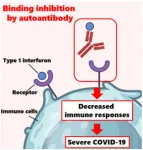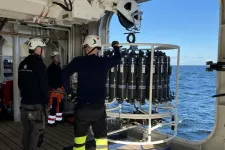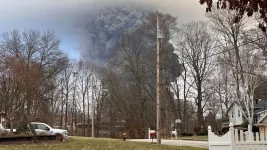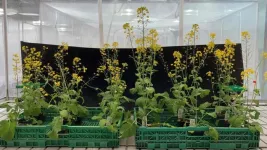The Sun Corridor in Arizona in the semi-arid Southwestern U.S. is a land of seeming unlimited growth that is constantly colliding with physical constraints. It is mountainous but also home to a large valley that includes one of the fastest growing metropolitan areas in the U.S.
While experiencing explosive growth, the Phoenix metropolitan area faces an uncertain future due to prolonged drought and fluctuating seasonal water availability. Planning for the future, especially in terms of water, has long been both a challenge and a staple of life in Arizona.
Now a team of researchers working with a weather model have uncovered new details of water availability in Arizona’s uplands and where that water comes from. The work may help in future planning of the Phoenix metropolitan area, as well as provide guides for coming precipitation seasons.
The Arizona uplands is home to the Salt-Verde watershed, which feeds the Arizona reservoir system and helps provide critical water resources needed to support the 5 million plus residents and businesses of Phoenix. The Salt-Verde watershed, located north-northeast of Phoenix, feeds a series of rivers in Arizona that provide about half of the municipal, industrial and agricultural water supply to the Phoenix metro area.
The rivers in this watershed are less sensitive to warming temperatures than many other important rivers in the western U.S. Therefore, warming temperatures are not an effective predictor of future Salt-Verde streamflow making the future of winter precipitation extremely important to understand.
The new work – carried out by a team of researchers from Arizona State University; Salt River Project (SRP), an Arizona utility; and Universidad de Santiago de Compostela, Spain – focuses on the precipitation in the Salt-Verde watershed during the winter months. It represents a new approach to improved precipitation predictability for Arizona and the Salt-Verde watershed.
Results of the work are reported in the paper Modeling Salt-Verde Watershed Winter Precipitation Using Convection-Permitting WRF-Simulations with Water Vapor Tracers in the current issue of the Journal of Geophysical Research – Atmospheres.
The researchers applied a model (the Weather Research and Forecasting model, or WRF) with an important refinement that has been used in only a few locations elsewhere in the world to improve understanding of precipitation predictability. This new work pinpoints where wintertime precipitation for Arizona comes.
One surprising finding is that it is not the area normally associated with El Niño/La Niña, (equatorial tropical Pacific). The team found that the sea surface temperature across an area bounded by 140°W and 100°W, excluding the El Niño/La Niña areas, is the dominant source area of water for wintertime precipitation for Arizona. Moreover, this new work indicates that if sea surface temperature anomalies, or deviation from an average value, of this newly pinpointed region is known then that information can be used as a guide to wintertime precipitation forecasting for Arizona.
“We have identified the main moisture source region for wintertime precipitation across Arizona’s mountains,” said Matei (Matt) Georgescu, an associate professor in Arizona State University’s School of Geographical Sciences and Urban Planning and the director of the Urban Climate Research Center. “This is a critical step in allowing us to improve seasonal precipitation forecasts for Arizona and potentially other regions across the globe as well.”
“The importance of evaporation from the Pacific Ocean near North America for Salt-Verde precipitation was surprising,” explained Bohumil (Bo) Svoma, a meteorologist at SRP and a co-author of the paper. “In the western U.S., much attention is given to atmosphere river events that bring moisture to the West Coast from sub-tropical areas farther west in the Pacific where warm oceans during El Niño events provide a significant source of moisture. Since El Niño events tend to result in wet winters for Arizona, it was surprising that this central Pacific moisture source is not as important for Arizona precipitation.”
Previous work by Svoma and Georgescu, led by Joseph Karanja, a PhD student at ASU, indicated that none of the standard El Niño/La Niña metrics provide a robust relationship determining spatial and temporal variability in historically observed wintertime precipitation for the Southwestern U.S.
In the new work, the researchers took historical data for three different types of El Niño/La Niña winters (warmer than average, average and cooler than average) and ran those through the WRF for the four-month periods of December through March to simulate precipitation and examine the model’s performance with the historical data on rainfall. In each case it did match, with the warmer (El Niño) winter coinciding with more precipitation, the normal winter with somewhat less and the cooler winter (La Niña) experiencing even less precipitation.
The researchers then reran the WRF model where they masked individual geographical regions, which determines how much water sourced from that specific area eventually falls as precipitation over the Salt-Verde watershed. In totality, these simulations revealed the main source for the precipitation Arizona typically experiences during winter. That location, an area bounded by 140° W and 100° W and south of 40°N, excludes the El Niño/La Niña area commonly referred to as the El Niño 3.4 region.
“Our work sheds new light by highlighting that the standard El Niño/La Niña region may be less important, at least in terms of direct water vapor transport for Arizona seasonal/ winter precipitation than previously thought,” Georgescu said. “Rather than focusing attention on sea surface temperature variability over the El Niño 3.4 region, we need to pay greater attention to sea surface temperatures closer to the U.S.-Baja coastline.”
“Even for the cold (i.e., La Niña) winter, where tropical sea surface temperatures are colder than average, more than half of the water that fell over Arizona originates from what we define as local sea evaporation, which we bound as between meridians 140° W and 100° W off the North American West Coast and south of 40° N,” said Francisco Salamanca-Palou, an ASU assistant research professor of Geographical Sciences and Urban Planning and lead author of the study.
The researchers say the tool can be useful to water managers in better understanding the source of water that falls in any location for a given storm or season. While it can be applied elsewhere, its use in Arizona is clear.
“Climate model projections of winter precipitation in Arizona are highly uncertain,” Svoma said. “Detailed research about the current climate is an important initial step for advancing our understanding of future precipitation in Arizona.”
“This research is critical for long term water supply planning in Arizona,” he added.
In addition to Georgescu, Salamanca-Palou and Svoma, other co-authors on the paper are Joseph Karanja of ASU; James Walter of SRP; and Damian Insua-Costa, Gonzalo Miguez-Macho of the Universidad de Santiago de Compostela, Galicia, Spain. The work was funded by SRP.
###
END






